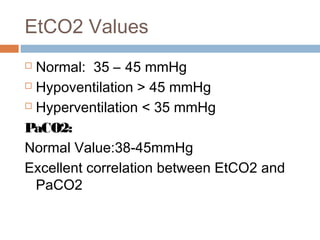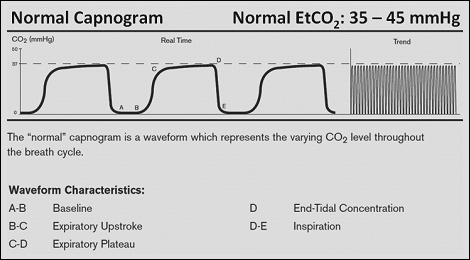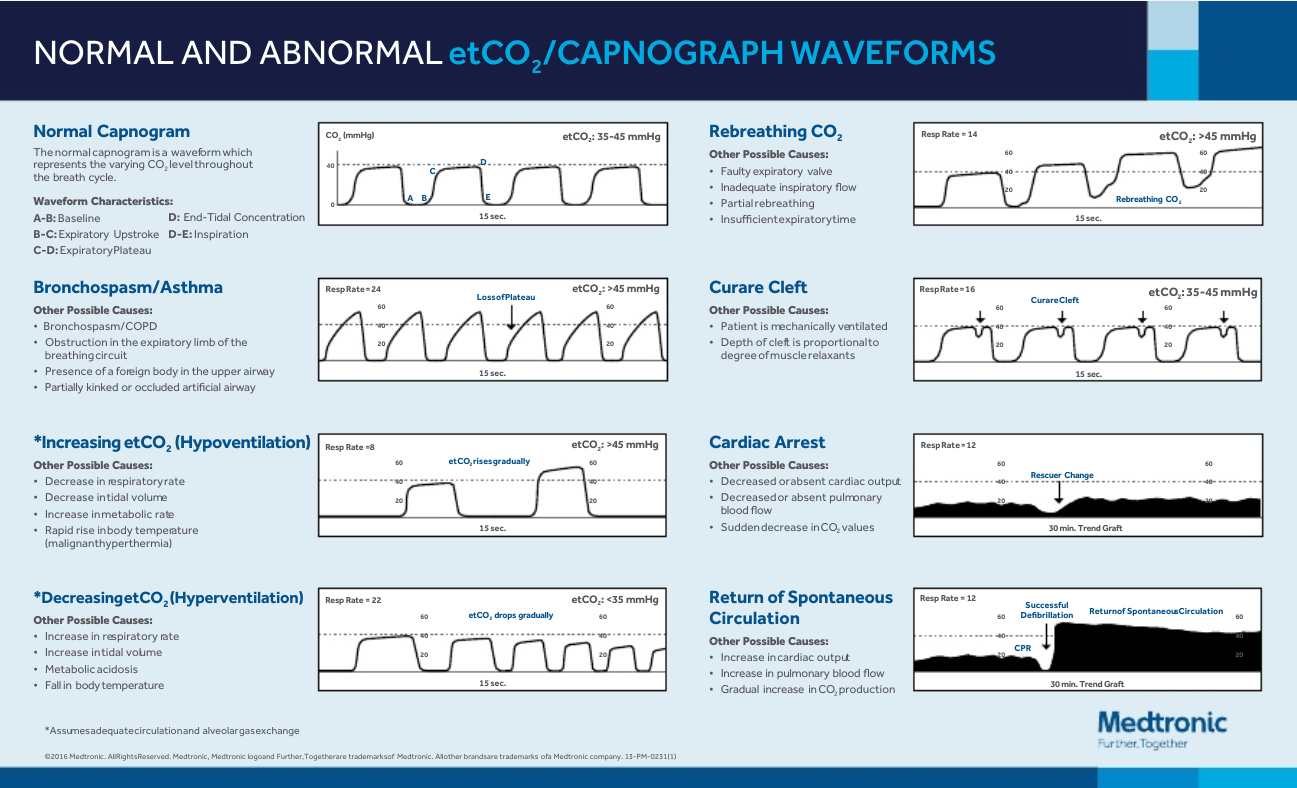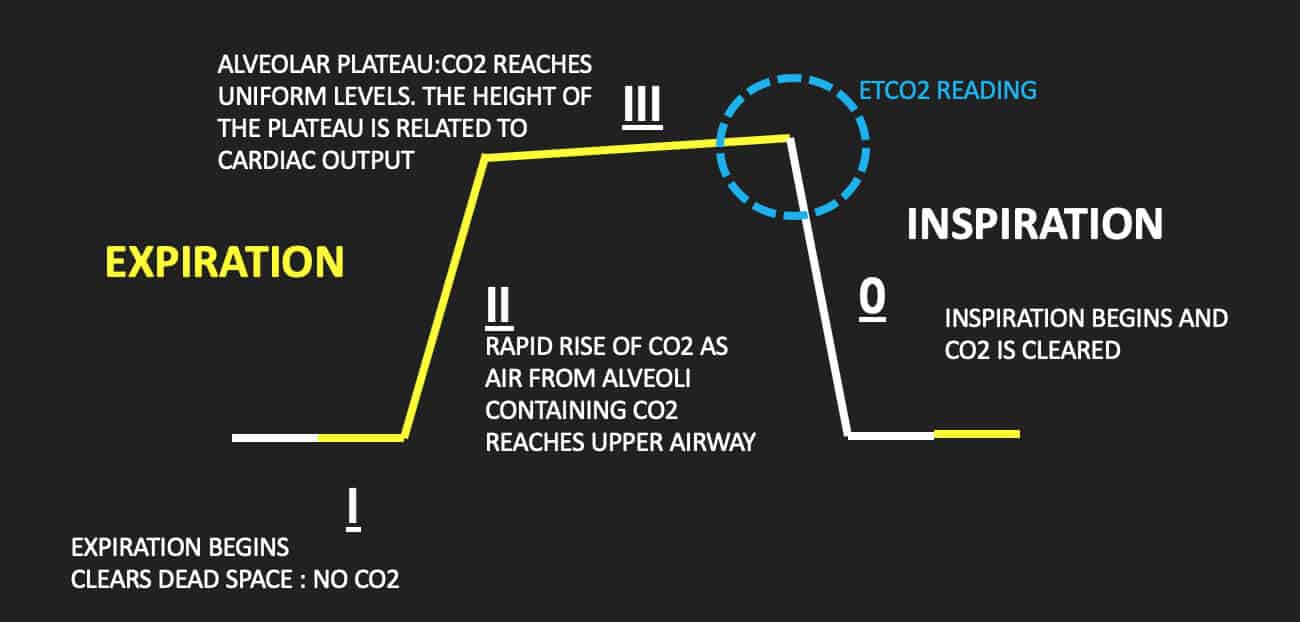normal end tidal co2 levels
End-tidal carbon dioxide ETCO 2 is the level of carbon dioxide that is released at the end of an exhaled breath. The amount of CO2 at the end of exhalation or end-tidal CO2 ETCO2 is normally 35-45 mm HG.

Etco2 In Non Intubated Patient A Must In Ed
On the other hand a high CO2 reading may indicate airway narrowing.

. More Than Just a Number. For a person with normal lungs the difference between end tidal and Paco2 can vary between 5-8mmHg depending on the book your reading. The normal alveolar CO 2 pressure is about 40 mm Hg pressure Guyton 1984.
These values are approximately 14 the normal EtCO2 35-45 mm Hg and ideal CPR will provide at least 14 of cardiac output. End tidal CO 2 monitoring. The normal range for CO2 in your blood is 23 to 29 mEqL.
End tidal CO 2 monitoring is represented as a number and a graph on a monitor. Levels of end-tidal carbon dioxide are low despite normal respiratory rate in individuals with long COVID. The normal values are 5-6 CO2 which is equivalent to 35-45 mmHg.
For 60 to 89 years old it is from 23 to 31 mEqL. A low end-tidal CO2 may indicate poor perfusion hypovolemia or sepsis. The number is called capnometry which is the partial pressure of CO 2 detected at the end of exhalation ranging between 35 - 45 mm Hg or 40 57 kPa.
ETCO2 levels reflect the adequacy with which carbon dioxide CO2 is carried in the blood back to the lungs and exhaled. For a person with normal lungs the difference between end tidal and Paco2 can vary between 5-8mmHg depending on the book your reading. The level of CO 2 gradually rises during exhalation showing an approximate equalization with the CO 2 value in alveoli in the lungs hence the phrase end-tidal.
End-tidal CO2 EtCO2 monitoring is a noninvasive technique which measures the partial pressure or maximal concentration of carbon dioxide CO2 at the end of an exhaled breath which is expressed as a percentage of CO2 or mmHg. Cardiac output and end-tidal carbon dioxide. The height of the capnography waveform accompanies this number on the monitor as well as the.
ETCO 2 levels reflect the adequacy with which carbon dioxide CO 2 is carried in the blood back to the lungs and exhaled. Relationship between cardiac output and the end-tidal carbon dioxide tension. ROSC is reflected by a sudden rise in EtCO2.
Ganong 1995 or partial pressure of 53 of normal air at. Ganong 1995 or partial pressure of 53 of normal air at sea level. Available evidence has established that ETCO 2 measurement can provide an indication of cardiac output and pulmonary blood flow.
End-tidal carbon dioxide as a noninvasive indicator of cardiac index. Jin X Weil MH Povoas H Pernat A Xie J Bisera J. The normal values are 5-6 CO2 which is equivalent to 35-45 mmHg.
So the short answer is you are right about the ranges 35-45 but that is for actual PaCo2 drawn from an ABG. According to age the normal CO2 level of an individual aging 18 to 59 years old is from 23 to 29 mEqL. Ornato JP Garnett AR Glauser FL.
2 to near normal normal EtCO 2 35-45 mmHg represents marked increase of CO 2 delivery to lungs suggesting ROSC If patient develops an organized rhythm after VFVTasystole check EtCO 2 to see if ROSC has occurred CONFIRM PLACEMENT OF ETT After intubation if ETCO 2 10mm Hg tube in trachea. Crit Care Med 198513907-9. This is an example of capnography during CPR.
Although the normal range for CO2 should be between 35-45mmHg CO2 monitoring gives healthcare providers a lot more insight into what is going on with a patients condition. Ann Emerg Med 1990191104-6. The waveform is called capnograph and shows how much CO 2 is present at each phase of the respiratory cycle.
The objectives were 1 to establish immediately upon arrival to the emergency department ED the prevalence of abnormal end-tidal carbon dioxide ETCO2 levels in patients with prehospital intubation and 2 to describe the relationship between abnormal ETCO2 levels on ED arrival and mortality. Levels of end-tidal carbon dioxide are low despite normal respiratory rate in individuals with long COVID J Breath.
End Tidal Co2 Monitoring In The Pre Hospital Environment More Than Just Endotracheal Tube Placement Confirmation Journal Of Paramedic Practice

End Tidal Capnography Can Be Useful For Detecting Diabetic Ketoacidosis Monitoring Copd Acep Now

Exhaled Carbon Monoxide End Tidal Co2 And Peripheral Oxygen Saturation Download Table

Waveform Capnography In The Intubated Patient Emcrit Project
Emdocs Net Emergency Medicine Educationcapnography In The Ed Emdocs Net Emergency Medicine Education

Average Etco2 Kpa During Cpr In Patients With Or Without Rosc Download Scientific Diagram

Normal And Abnormal Capnography Waveforms Infographic Capnoacademy Capnoacademy

Waveform Capnography In The Intubated Patient Emcrit Project

Figure 1 From Applications Of End Tidal Carbon Dioxide Etco2 Monitoring In Emergency Department A Narrative Review Semantic Scholar
5 Medical Conditions Where Capnography Can Affect Bls Care Capnoacademy Capnoacademy

Waveform Capnography In The Intubated Patient Emcrit Project

Basic Capnography Interpretation Nuem Blog

Capnogram R Series Defibrillator Zoll Medical Uk
Riding The Wave Of Capnography Understanding Etco2 Vetbloom Blog

Exhaled Carbon Monoxide End Tidal Co2 And Peripheral Oxygen Saturation Download Table

Basic Waveform Capnography As A Continuous Monitoring Tool During Mechanical Ventilation

Capnography Provides Bigger Physiological Picture To Maximize Patient Care Jems Ems Emergency Medical Services Training Paramedic Emt News
